|
Background
The 21st century will be dominated by the quest for and
access to the world’s energy sources.
It is expected that by 2020, world oil consumption will rise
by about 60%. The two countries with the highest rate of
growth in oil use are
China and India, whose combined populations account for a
third of humanity. In the next two decades, China's oil
consumption is expected to grow at a rate of 7.5% per year and
India’s 5.5% (compared to a 1% growth for the industrialized
countries).
Of the trillion barrels of currently estimated total world
oil reserves, 6% are in North America, 9% in Central and Latin
America, 2% in Europe, 4% in Asia Pacific, 7% in Africa. But
over 70 % of them lie in the West and
Central Asia
and Asiatic Russia ––
Saudi Arabia (25%),
Iraq (11%),
Iran (8%),
UAE (9%),
Kuwait (9%), and 6%
each in Russia and Central Asia. In addition, Russia holds the
world's largest natural gas reserves,
Iran
the second largest and Central Asia in substantial quantities
too. The geological potential in Central Asian states is still
under-explored, so the region may actually contain much more
oil and gas than generally known today.
Kazakhstan,
Azerbaijan,
Turkmenistan and
Uzbekistan
share the majority of the region's hydrocarbon wealth. But
being landlocked countries, they all depend on their
neighbours –– Russia, the Caucasian States of Georgia and
Armenia and Turkey for access via pipelines to the Western
markets and Kyrgizstan, Tazakhstan and Afghanistan to China,
Pakistan and India. While there is already a good network of
pipelines via
Russia,
the new thrust is to create alternative routes to get out of
the bear-hug.
Oil was first discovered in
Azerbaijan
and a primitive oil industry set up in Baku by the early 19th
century. Because of this, Central Asia in the last two
centuries played an important role in the geopolitical balance
of Eurasia. In World War II, during his campaign against
Russia,
Adolf Hitler sought to capture Baku and the Caucasian oil
fields in a bid to replenish his depleted fuel supplies before
attacking the Middle East. After the war, the Soviets took
over control of the Central Asian oil and gas fields. Now with
the collapse of the Soviet Union, the independent republics of
Central Asia realizing oil to be the fastest way for them to
secure their economic and political independence, have sought
to exploit their oil wealth, thereby leading to a renewed
struggle for political and economic hegemony in the region.
Besides
Russia, USA
and China have emerged as the main contenders with
Iran
playing a side role. Their aim is control of oil and gas
production as also the pipelines that deliver the energy
resources. The transit route through Iran to the Gulf would be
the most economical outlet but the US seems determined to
block it, because such a solution will strongly reinforce
Iran’s position in both the world oil market (change over to
Euros from Dollars and transit for the oil) and in the
political context of
West Asia. With
Iraq and
Afghanistan already in its politico-military sway,
undercutting
Iran
is an obvious way for the US to exercise containment of the
emerging world power –– China and keeping Russia within
manageable bounds. This may be the prime reason for making so
much fuss on Iran’s nuclear activities. Japan is another major
importer of oil, for geographical reasons, has made moves only
towards the Iranian and Russia’s Siberian oil and gas reserves
on purely commercial terms.
The 9/11
Effect
The
US undertaking of war on terror after 9/11 and in the light of
the rise of radical Islam, America is now considering
reduction of its dependence on
Middle East
oil. Moreover, to offset the growing influence of
Middle East
oil producers, non-OPEC countries in
Africa and
Russia have increased their production considerably. It has
even been suggested that Russia could take on OPEC and help
shift the hub of global oil supply away from the Middle East.
Even though Russia’s oil production did increase to the point
that it became the second largest exporter behind Saudi
Arabia, its prospects of becoming a key player in the oil
market in the long run are dim because of the depleting
reserves.
United States, which consumes more energy than any other
country in the world, imports roughly half its oil. Hence oil
plays a key role in its strategic manoeuvres in the world in
general (Venezuela/Nigeria/Indonesia) and
Asia in particular. So the great game over Central Asian energy
resources is the ‘flavour’ of the new century.
Russia being
a constant factor, seeks to retain both economic and political
control of the region. In the Soviet era, it had already
connected Azerbaijan and other Central Asian republics to its
territory and
Europe by a network of oil and gas pipelines. The
United States
having now emerged as the world’s sole superpower, has
universal interests. As the world’s leading oil importer
harbouring the major part of the world’s oil industry, it has
a persistent interest and a stake in and preferably a control
of the world’s major oil producers, wherever they are. The
Central Asian oil and gas reserves therefore present a
tempting fare to
US
oil companies, thereby making Washington evince an avid
interest in this region. The politico-military aspect of the
power play has been covered in a previous article
“Central Asia –– A Chessboard of Power Play”. The intricate game over
energy in the region is detailed in the succeeding paragraphs.
Control
over Oil and Gas
For
Russia energy has emerged as a tool for strategic leverage, in
effect replacing its traditional reliance on the "hard power"
of military with a new exercise of the "soft power" of energy
resources. The use of this soft power as leverage consists of
three components. First, it has supplemented, and in some
cases even projected, an effective reassertion of Russian
power and influence within the so-called "near abroad" of
former Soviet states. Most notably, this can be seen in the
Russian dominance over the energy sectors of much of the South
Caucasus and Central Asia. Second, it has also featured the
use of energy as a tool for strengthening state power,
empowering Russia's status as a regional and an Asian power.
And thirdly, it has afforded Moscow an attractive way to
restore its international position and regain its geopolitical
relevance. Russia signed a long-term cooperation accord with
Turkmenistan
covering natural gas exploration, production, processing,
transport, and marketing. Just ten days before this deal,
Gazprom announced having reached a similar agreement with
Kazakhstan over that country's oil resources. It has also a
fair share of the Azeri oil and gas resources though the US
and Europe have managed to cut into the bounty.
Russia
has also succeeded in stalling US political and military
forays in all Central Asian states and at present glides
smoothly over the present and future energy sources of the
region with China as a strategic partner.
In Oct 05,
Beijing
scored a second major geopolitical coup when it completed a
$4.18 billion takeover of PetroKazakhstan Inc. It was, in a
sense, revenge on
Washington
for the blocking of China’s acquisition of Unocal. US oil
majors had made major efforts to lock up
Kazakhstan
oil after discovery of major oil offshore in the Kashagan
field. The Kazakh president Nazarbayev, in spite of having
good relations with Russia's Putin (he was general secretary
of the Communist Party when Kazakhstan was part of the USSR),
kept his reputation of being a sly fox in dealing with Moscow,
and turned down Russia's Lukoil offer for the PetroKazakhstan
Inc, while the Indian bid was pipped by the Chinese. Before
that Condoleezza Rice's company, Chevron, was the lead oil
contractor and operator in the Kazakh Tengiz oil field. Now, a
decade later and with the scope of Kazakh oil deposits
dwarfing others in the region (estimated to be twice that of
North Sea) with its recent confirmed drillings in the Kashagan
field, Nazarbayev has scored a political balance of power coup
by turning to Beijing.
Earlier at the end of 2004,
Beijing
signed a $100 billion deal with Iran to import 10 million tons
of liquefied natural gas over a 25-year period in exchange for
a Chinese stake of 50% in the development of the giant
Yadavaran oilfield. This is China's largest OPEC energy deal
todate and includes construction of related petrochemical and
gas infrastructure as well as pipelines. A second phase in the
Iran–China strategic energy cooperation will involve
constructing a pipeline in Iran to take oil some 386
kilometers to the Caspian Sea, there to link up with the
planned pipeline from China into Kazakhstan. On signing the
deal, Iran's Petroleum Minister announced that Tehran would
like to see China replace Japan as Iran's largest oil
importer. Iran now supplies about 14% of China's oil.
PetroChina recently inked a MoU with
Myanmar to
supply 6.5 trillion cubic feet of gas from Block ‘A-1’ of the
Shwe gasfields in the Bay of Bengal for over 30 years. The
decision came as a major blow to India whose
two state owned companies –– ONGC
and GAIL –– hold 30% equity in it. It also marked one
more victory for
Beijing
energy giants which have consistently been beating Indian
energy firms in the acquisition of oil and gas reserves around
the world. India's state-owned oil giant Oil and Natural Gas
Corporation (ONGC) has lost to Chinese companies, in
Kazakhstan, Ecuador, Angola and Nigeria. Now, with Block A-1
gas from Myanmar going to China, the cost of transportation
will increase as the other available block close to India is
A-2, which will require an additional 150km of pipeline for
the gas to reach here. India’s oil diplomacy has not been
sufficiently geared to meet the competition from China. The
cash-rich Chinese firms are favourably placed as they can
dispense government aid to secure deals as well as draw on
hefty credit lines from Chinese financial institutions.
India has
made moves to buy 7.5 million tons of LNG a year for 25 years
from Iran but the deal has not yet been ratified by the
Iranian President and there is now a question mark over it due
to
India’s
vote on referring Iran’s nuclear affairs to UNSC.
India's
Petronet and Qatar's Ras Laffan LNG Company (Rasgas) have
signed an agreement for the provision of 10.3 billion cubic
meters per year of LNG, and deliveries began in January 2004.
India has also taken equity stake in
Russia’s
Sakhalin oil/gas fields.
Besides already having secured sizeable oil supplies from
Tehran, Japan two years ago sealed a deal with Iran on a
billion-dollar project to develop Azadegan oil field,
estimated to hold the World's second-biggest single oil
reserves. Of late
Washington
has raised objections to this deal.
Iran as
Japan's
third-largest oil supplier provides 14% of
Tokyo’s needs.
Japan has
also made large investments in the development of Russia’s
Siberian oil and gas fields. Offshore of Russia’s Sakhalin
Island, Japanese companies are participating in the first $10
billion slice of what could be a $100 billion development of
oil and gas reserves believed to rival the North Slope of
Alaska. Japan imports nearly 60 percent of its oil from the
Arab countries.
With gas emerging as an equally valuable energy source,
China
and Japan are shadowing each other in the East China Sea. With
China laying a 300-mile gas line to offshore deposits, Japan
has complained that China will tap into a 246 billion cubic
meter gas field that is partly Japanese. With each country's
exclusive economic zone in dispute,
China's
moves to develop the gas have been met by Japanese
naval/survey ships, exploring the contested area in the
southern tip of
Okinawa
Prefecture.
In the rivalry between Japan and China for Russia's eastern
petroleum, China seems to have surged ahead as during his
recent visit to
Beijing
on 21–22 Mar 06, Putin declared that
the planned natural gas pipeline to
China would begin delivering gas within five years and supply
up to 80 billion cubic meters annually. The gas supplies would
come from fields in both western and eastern Siberia.
Russia has also promised to ship 15 million tons of crude oil
in 2006, more than a tenth of China’s needs.
Race for Pipelines
Baku–Tblisi–Ceyhan
(BTC) Pipeline.
The 1,700 km, $3.6 billion
Baku
(Azerbaijan)–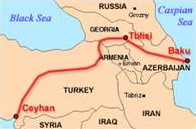 Tblisi (Georgia)–Ceyhan (Turkey) oil pipeline
that opened in May 05 is a
US
sponsored move to bypass Russia, Black Sea and Bosphorus for
oil supplies from
Azerbaijan and
other states of Central Asia. It plans to eventually pump one
million barrels of oil per day up to the Mediterranean Sea
close to the Syrian coastline. The present US thrust against
Syria could well have more to do with the fact that the Syrian
coastline is too close to where this pipeline ends than with
the so-called foreign insurgents in Iraq. Question marks about
BTC’s economic viability have arisen as the Azeri oil wells
are depleting and Kazakhstan is yet to commit its oil to this
pipeline. The
US
is trying hard to persuade Alma Ata to opt for the Baku–Ceyhan
pipeline for the flow from the Kashaghan oilfields and
president Bush is due to visit Kazakhstan later this year. Tblisi (Georgia)–Ceyhan (Turkey) oil pipeline
that opened in May 05 is a
US
sponsored move to bypass Russia, Black Sea and Bosphorus for
oil supplies from
Azerbaijan and
other states of Central Asia. It plans to eventually pump one
million barrels of oil per day up to the Mediterranean Sea
close to the Syrian coastline. The present US thrust against
Syria could well have more to do with the fact that the Syrian
coastline is too close to where this pipeline ends than with
the so-called foreign insurgents in Iraq. Question marks about
BTC’s economic viability have arisen as the Azeri oil wells
are depleting and Kazakhstan is yet to commit its oil to this
pipeline. The
US
is trying hard to persuade Alma Ata to opt for the Baku–Ceyhan
pipeline for the flow from the Kashaghan oilfields and
president Bush is due to visit Kazakhstan later this year.
Kazakhstan–China
Pipeline.
On 15 Dec 05, the state-owned China National Petroleum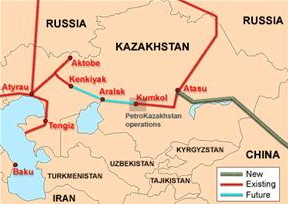 Corp (CNPC)
inaugurated an oil pipeline running from Kazakhstan to
northwest China. The pipeline undercuts the geopolitical
significance of the Washington-backed Baku–Tbilisi–Ceyhan (BTC)
oil pipeline which opened earlier last summer amid big
fanfare. Corp (CNPC)
inaugurated an oil pipeline running from Kazakhstan to
northwest China. The pipeline undercuts the geopolitical
significance of the Washington-backed Baku–Tbilisi–Ceyhan (BTC)
oil pipeline which opened earlier last summer amid big
fanfare.
Making the Kazakh–China oil pipeline link even more
politically interesting, from the standpoint of an emerging
Central Asian move towards some form of greater energy
independence from
Washington,
is the fact that Russian companies have agreed to help fill
the pipeline with oil, until the Kazakh supply is sufficient
thereby implying closer China–Kazakhstan–Russia energy
cooperation. This pipeline runs 962 kilometers and will take
China a third of the way to Kashagan in the Caspian Sea. Once
the link between Kenkiyak and Kumkol is finished, connecting
existing infrastructure near the Caspian with the portion
inaugurated on 15 Dec, the project will pump 1 million bpd.
That would be about 15% of China's crude oil needs. China then
plans to tap into production from dozens of Kazakh sites it
has acquired during the past several years. This is the oil
that currently goes west, or north through Russia. There is
also a proposal to connect this pipeline with the Iran’s oil
from the giant Yadavaran fields which
China
has contracted to develop.
The Japanese Route –– Angarsk–Nakhodka
The Chinese/Japanese competition for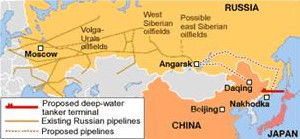 becoming the primary partner for Russian energy exports from
the Far East is much less a commercial competition than a
complex game as in the case of the Baku–Ceyhan oil pipeline
where geopolitical considerations far outweigh any and all
commercial aspects. The Japanese route, from
Angarsk
to Nakhodka, would be roughly double the price and, at a
projected 3,700 kilometers, would be significantly longer than
the Chinese alternative to Daqing. For
Tokyo,
the Angarsk–Nakhodka pipeline is significant for two strategic
reasons. First, the pipeline could result in a substantial
reduction in Japan's reliance on Middle East oil imports. The
second strategic factor stems from the fact that if Tokyo is
able to conclude a successful agreement with
Russia,
it would represent a strategic reengagement with
Moscow
–– important in view of the marked decline in Japanese
economic and political influence, and even presence, in
Russia. But the main obstacle for this project is the
territorial dispute with Russia over the Kurile Islands which
is rooted in history and remains an unresolved issue.
becoming the primary partner for Russian energy exports from
the Far East is much less a commercial competition than a
complex game as in the case of the Baku–Ceyhan oil pipeline
where geopolitical considerations far outweigh any and all
commercial aspects. The Japanese route, from
Angarsk
to Nakhodka, would be roughly double the price and, at a
projected 3,700 kilometers, would be significantly longer than
the Chinese alternative to Daqing. For
Tokyo,
the Angarsk–Nakhodka pipeline is significant for two strategic
reasons. First, the pipeline could result in a substantial
reduction in Japan's reliance on Middle East oil imports. The
second strategic factor stems from the fact that if Tokyo is
able to conclude a successful agreement with
Russia,
it would represent a strategic reengagement with
Moscow
–– important in view of the marked decline in Japanese
economic and political influence, and even presence, in
Russia. But the main obstacle for this project is the
territorial dispute with Russia over the Kurile Islands which
is rooted in history and remains an unresolved issue.
The
Chinese Route –– Angarsk–Daqing
The Chinese route, running from Angarsk to China's
energy-rich region of Daqing, would be considerably shorter,
at 2,400 kilometers, and significantly cheaper –– costing $1.7
billion as against $5 billion for the Nakhodka terminal, thus
making it practical to build for 600,000 barrels a day of
exports, an amount that the region could produce. The pipeline
would be the largest economic cooperative endeavour between
Russia
and China and significantly during his visit to Beijing on 22
Mar 06, president Putin had affirmed that this project would
be completed within the next five years.
Turkmenistan–Afghanistan–Pakistan–India (TAPI) Pipeline
With a cloud over the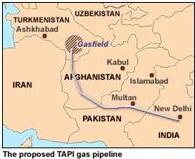 Iran–Pakistan–India (IPI) gas
pipeline due to US objections,
India
has virtually decided to join the US-backed
Turkmenistan–Afghanistan–Pakistan–India (TAPI). Paradox-ically,
New Delhi has found an uncommon ally in Islamabad, which is
pushing for India's involvement in the TAP as well as the IPI. Iran–Pakistan–India (IPI) gas
pipeline due to US objections,
India
has virtually decided to join the US-backed
Turkmenistan–Afghanistan–Pakistan–India (TAPI). Paradox-ically,
New Delhi has found an uncommon ally in Islamabad, which is
pushing for India's involvement in the TAP as well as the IPI.
Afghanistan
and Pakistan have been seeking India's participation as vital
for the TAPI's viability, which would stretch from the
Turkmenistan–Afghanistan border in southeastern
Turkmenistan
to Multan, Pakistan (1,270 kilometers), with a 640km extension
to
India.
The TAPI not only provides a southern exit route for the
land-locked Central Asian gas that will not have to cross Iran
or Russia, it is also an important cog in Washington's Afghan
rehabilitation plan as it will earn substantial transit fees.
With potential hydrocarbon reserves of over 45.44 billion
tonnes of oil equivalent, Turkmenistan can significantly
increase supplies to the international market. As on 18 Mar
06, Pakistan has decided to start the $5 billion pipeline
project to import gas from Turkmenistan provided Ashgabad
confirms availability of sufficient reserves.
Iran–Pakistan–India (IPI) Gas Pipeline.
While India, Pakistan and Iran go through the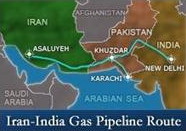 motions of
pursuing the IPI project, apparently unaffected by the
International Atomic Energy Agency's referral of
Tehran
to the UN Security Council, most observers claim that the
prospects of the pipeline materialising are now remote. The $7
billion pipeline that Washington opposes would be 2,700
kilometers long and was first proposed in 1994 but progress
has been slow, firstly due to tensions between the nuclear
armed rivals and neighbors India and Pakistan and secondly
because USA has put it on the chopping block. motions of
pursuing the IPI project, apparently unaffected by the
International Atomic Energy Agency's referral of
Tehran
to the UN Security Council, most observers claim that the
prospects of the pipeline materialising are now remote. The $7
billion pipeline that Washington opposes would be 2,700
kilometers long and was first proposed in 1994 but progress
has been slow, firstly due to tensions between the nuclear
armed rivals and neighbors India and Pakistan and secondly
because USA has put it on the chopping block.
All the same, the three sides have been talking and there are
some differences over the pricing. Another one is on terms of
payment.
Iran insists
that India sign a "take-or-pay" contract, meaning that India
would be obliged to pay for gas whether the gas was actually
imported and consumed. But India has suggested a
"supply-or-pay" arrangement in which Iran is contractually
obligated to deliver gas at the Indian border with Pakistan,
or else pay for the quantity not delivered. Further, the
Iranian vice president Rahim Mashaee during his visit to Delhi
on 27 Mar 06 said there is “good news” on IPI and in-principle
clearance had been given.
The
Myanmar–China Gas Pipeline.
Myanmar
is taking India for a ride on supplying gas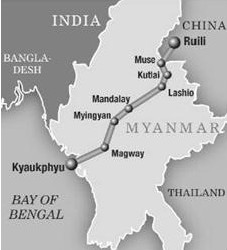 from fields where two Indian state owned companies hold 30%
equity. While assuring
New Delhi’s
share, it is going ahead with plans to lay an export pipeline
to China in return for soft loans to jack up its own drilling
capabilities. Myanmar has been getting impatient with
India
over the delay in settling the transportation issue over the
Myanmar–Bangladesh–India (MBI) pipeline.
from fields where two Indian state owned companies hold 30%
equity. While assuring
New Delhi’s
share, it is going ahead with plans to lay an export pipeline
to China in return for soft loans to jack up its own drilling
capabilities. Myanmar has been getting impatient with
India
over the delay in settling the transportation issue over the
Myanmar–Bangladesh–India (MBI) pipeline.
The survey by PetroChina for laying a 2,380-km pipeline from
Myanmar’s Kyaukphyu in the Bay of Bengal to Ruili in China
has been completed. China’s MoU with
Myanmar envisages supplying 6.5 tcf (trillion cubic feet) of
gas for 30 years from Block ‘A-1’ field in which ONGC Videsh
owns 20% and GAIL 10% equity. Now the available block
close to Bangladesh bordering area is ‘A-2’ and if the Myanmar
authorities want to sell gas to India, at least 150 km
additional pipeline will have to be built to bring gas to
India. The earlier project was mainly designed to bring gas to
India from Myanmar's A-1 block, which is near to Teknaf of
Bangladesh.
Myanmar–Bangladesh–India
(MBI) Gas Pipeline. A year after
India, Myanmar and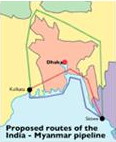 Bangladesh signed a trilateral pact to
collaborate on the MBI project, serious doubts over its
viability have arisen due to differences over many other
issues between New Delhi and Dhaka. Bangladesh signed a trilateral pact to
collaborate on the MBI project, serious doubts over its
viability have arisen due to differences over many other
issues between New Delhi and Dhaka.
Though
Bangladesh stands to earn substantial transit fees of $125
million per year, it has set conditions that include creation
of corridors through
India
to carry out trade with other neighbors, such as Nepal and
Bhutan, as well as steps to reduce its $2.5 billion trade
deficit with India. New Delhi appears to have made up its mind
to bypass Dhaka, even though the cost of the pipeline stands
to increase substantially. At the third meeting to which
Bangladesh was not invited, New Delhi talked of the
possibility of constructing the pipeline from Myanmar into
Mizoram and onwards to Assam and culminating in West Bengal.
The shortest pipeline route is from
Myanmar
to Bengal through Bangladesh while the alternative land route
would be twice the distance. India is also considering
shipping the gas as LNG/CNG, in an
undersea pipeline or a swap deal.
Conclusion
The race for
energy resources in Asia is being run by many contenders some
established ones and the others as new entrants. Russia has a
historical advantage and with
China and
Iran in the
team, it seems to have checkmated
USA for the time being.
China is
likely to substantially reduce its oil imports by sea from
Iran and Middle East thus avoiding American military threat
from sea and airborne attacks. However, Japan and India will
have to depend mostly on this mode of supply which requires
constant maritime security. Does that mean greater
US–Japan–India naval cooperation? What problems could Pakistan
in league with China pose to India with its Gwadar port nearly
ready? Could Iran–Pakistan–India pipeline be an antidote?
Answers to these questions lie in how the concerned countries
would act in pursuance of their respective interests. But the
next 20 years are going to be filled with tremendous interest
and excitement.
India will be
watching the expanding horizons of Russia–China energy
cooperation with mixed emotions. Last year at a meeting of the
newly constituted business council in Vladivostok between the
foreign ministers of India, China and Russia, New Delhi had
signaled that energy cooperation is at the top of its
concerns, while working with Russia and China in a new spirit
of regional cooperation. Russian–Chinese cooperation holds
implications for India in terms of the politics of energy
security. It underscores the reality that while nuclear energy
could be an option for meeting energy needs in the medium and
long term, oil and gas will remain the main sources of energy,
at least for the next quarter century –– especially gas.
India
would therefore have to closely monitor how the
Russian–Chinese equations develop in the fields of oil, gas
and nuclear energy.
India also
cannot overlook that Russia and Iran are the only viable
sources of gas supplies for the Indian market. Also, Russia
virtually controls the entire gas flows of the post-Soviet
space, including Central Asia. From the perspective of energy
diplomacy, therefore, India's friendly relations with Russia
and Iran assume a greater criticality than ever. This brings
back to focus the Iran gas pipeline project for India (IPI),
no matter what
Washington
may tell Delhi. Furthermore, in the light of the upcoming gas
pipelines from
Siberia into
China, Delhi
should look seriously at the viability of extending these
Russian pipelines to India through China in possibly in a
rough north–south direction along the existing railway lines
and roads in Kazakhstan and the Xinjiang region of China. For
any of the possible pipeline grids, the hubs would be Urumchi
and Kashgar in Xinjiang and then to Yarkand, Shahudullah and
India.
China holds the key to the success of such pipeline
alignments.
China could
conceivably be interested in swap deals with
India,
namely, buying India's oil and gas in Sakhalin in exchange for
the oil and gas produced in its assets in Xinjiang and
Kazakhstan. There could be an overland route via
India
to China for the Persian Gulf region oil/gas (extension of IPI)
which can do away with the long and perilous supply lines
through the Indian Ocean via the Malacca Strait and the South
China Sea. The proposed TAPI could also be extended to
Kazakhstan
to integrate the Central Asian oil and gas resources. All this
may appear wishful thinking but economic interests invite us
to give these ideas serious consideration and diplomatic
momentum. In the present day world, economic interests
overwhelmingly drive national policies and can bring what
appears far fetched today, in the realm of reality tomorrow. |